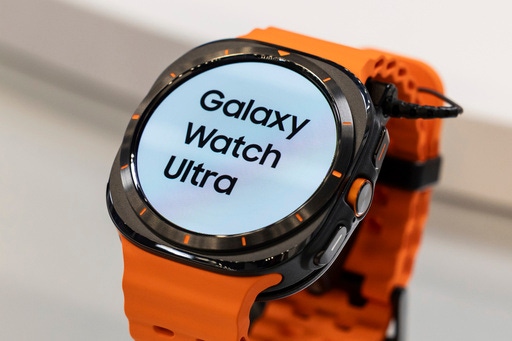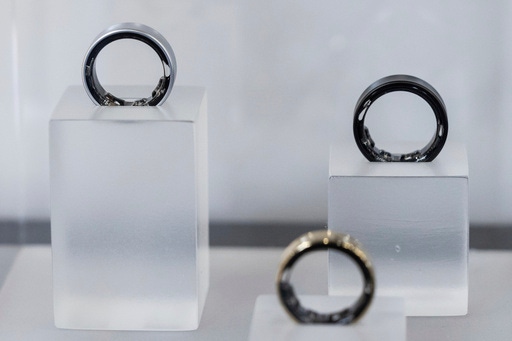Samsung brings tech’s latest fashion to wearable technology with AI twists in new watch and ring

Samsung Galaxy Watch Ultra is displayed during a media preview at Samsung Galaxy Experience space, Tuesday, July 9, 2024, in New York. Samsung is dressing up its wearable devices in technology's latest fashion — artificial intelligence. (AP Photo/Yuki Iwamura)[ASSOCIATED PRESS/Yuki Iwamura]
SAN FRANCISCO (AP) — Samsung is dressing up its wearable devices in technology’s latest fashion — artificial intelligence.
The South Korean electronics giant on Wednesday revealed that both its first-ever premium smartwatch and a smart ring heralding its entry into a niche market will include AI features that are supposed to help people monitor and manage their health.
Both the Galaxy Watch Ultra, priced at $650, and the Galaxy Ring, priced at $400, are extensions of a push that Samsung launched six months ago when it introduced its first smartphones to feature AI technology as a main attraction. The high-end smartwatch costs twice as much as Samsung’s latest standard model, the Galaxy Watch 7, which will sell for $300.
Tethering AI to people’s essential devices has become an accelerating trend. The technology already has been implanted on smartphones made by Google and Apple that compete against Samsung and also on the latest personal computers powered by Microsoft’s Windows software.
The AI deployment on Samsung’s new premium watch and ring is narrowly focused on improving and maintaining personal health — the main reason most people buy wearable technology.
Both Samsung’s watch and ring are leaning on AI to do a better job of analyzing biometric data collected from the person wearing the devices to customize assessments of their well-being through an “energy score” that will deliver ratings on a one to 100 scale and also make recommendations like a virtual fitness coach.
Just as Apple plans to do with its AI services, Samsung’s new wearable products will collect most sensitive information on the devices themselves. But some data will still be processed through remote computing centers with a “defense-grade, multi-layer security platform” that Samsung likens to a virtual Fort Knox, echoing Apple’s pledge to corral any personal information that must be processed off a device in a digital fortress. But those promises don’t necessarily guarantee there won’t ever be security breaches or other breakdowns that unintentionally exposes personal information to outsiders.
Samsung’s premium phone is the more sophisticated of its latest wearable devices, capable of performing some functions — such as flagging sleep apnea — that the Galaxy Ring can’t. However, the ring requires less frequent recharging, equipped with a battery that can last six to seven days before needing to be replenished.
But the smartwatch is also in a much more crowded market currently led by Apple, which has been intensifying its focus on health features since entering the market a decade ago. More than 60 million people already use the Samsung Health app that works in tandem with its smartwatches.
The health benefits associated with wearable technology have helped spur more people to buy smartwatches, with worldwide sales of the devices expected to approach about $29 billion this year, based on a forecast by the research firm Gartner Inc. That translates to roughly 164 million new smartwatches being worn on wrists this year, with Gartner predicting the annual sales volume sold will rise to 195 million in 2028.
Samsung is likely to face more challenges in the smart ring market, even though it won’t be facing much competition so far. The segment so far has been shaped by startups such as Oura and RingConn that haven’t made a significant dent so far.
“Smart rings are still an emerging category with no exclusive use cases, with little expectations of growing beyond a niche market” through 2028, Gartner said in its recent overview of the wearable technology market.
The firm expects a small segment that includes smart rings to generate $2.4 billion in sales this year and eventually rise to about $4.6 billion in 2028.
Although it will come in nine different sizes, Samsung’s Galaxy Ring only fits with one kind of software — Google’s Android operating system. That locks out the mostly affluent consumers who own iPhones and often are interested in checking out new forms of technology such as the Galaxy Ring.
Samsung also is rolling out its latest attempt to lure more people into buying a foldable phone equipped with two display screens that can be hinged together so the device can be turned into a pseudo-tablet. It’s a concept that Samsung has pushing since 2019 with minimal success, but the company is continuing to update the device with camera and AI features to feed the niche market. The next-generation model, the Galaxy Z Fold 6, will sell for $1,900.
Meanwhile, unionized workers in South Korea declared an indefinite strike to pressure Samsung to accept their calls for higher pays and other benefits. Thousands of members of the National Samsung Electronics Union launched a temporary, three-day strike on Monday. But the union said Wednesday that it was announcing an indefinite strike, accusing the management of being unwilling to negotiate.
Samsung claims there have been no disruptions to production.
—-
This story has been corrected to reflect the price for Samsung’s standard watch starts at $300, instead of $350 as reported in a previously version.
Copyright 2024 The Associated Press. All rights reserved. This material may not be published, broadcast, rewritten or redistributed without permission.
